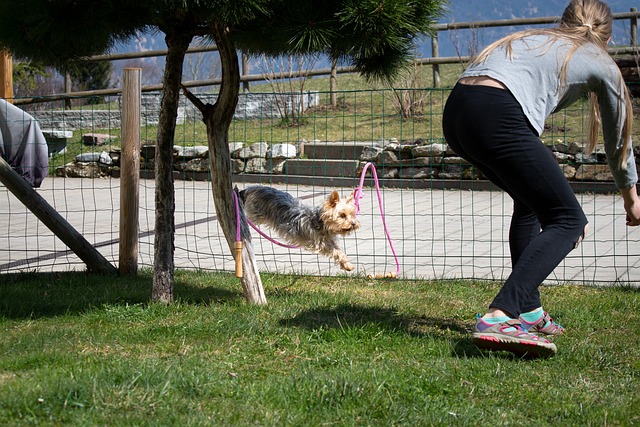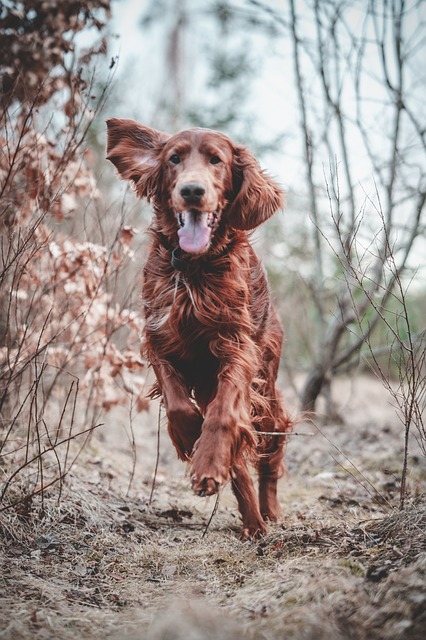Having A Dog That Listens Is Important

You love your dog and you also care about all of your possessions. Dogs will not value your things and they will chew toy. The article below has tips and tips that can help train your dog effectively.
Shock collars are not a good idea. They are both expensive and unlikely to work properly. They can cause your dog to be confused about all their behaviors. Usually if you do this your dog will respond in the wrong way.
The rule of thumb with puppies and house training is to remember: what is eaten will eventually come out the other end. Feed your dog a high-quality diet three times regularly each day. This will get your dog out and avoid accidents.
Start training with something simple. This will cause you to get your dog to learn its first trick quickly, which is rewarding. It will also show your dog what training is all about. This gives you awesome results during the training process.
Give your dog a word that means “yes” to aid in training.
Remember to enjoy the time spent with your dog during training. Try and develop a bond with your dog by playing with him, it will only encourage the dog to want to please you more during training. Although training itself is fun, it is good to spend time each day just playing with your dog because you can.
It is very easy to teach a roll with treats. Start by getting the animal to lie down.Then, put a treat close to the floor near the side of the dog’s head, causing him to roll over. He should roll over while following the treat.
Make sure to give your dog a good hour of exercise each and every day. A dog that is physically active and has the chance to exercise regularly is more capable of learning during training sessions. If your pet can exercise regularly and be active, he will be far more happy and responsive.
Avoid costly training devices which are high end such as shock collars. They may not work very well and cost more than training methods which are conventional. They can also discourage good behaviors as they inhibit your dog to be confused about all their behaviors.
Let your dog get used to triggers that make them bark to reduce the behavior. Everything from a sound to a particular person could be a trigger. Your dog will know the difference and will understand that there’s no reason to bark when presented these situations.
One command that should be taught early to a puppy is “leave it.” This teaches them to drop something and step away from things you do not want him to touch.This command teaches them to cease chewing on something he shouldn’t and it keeps them safe from dangerous items.
It is vital to keep some slack in the leash when you are trying to train a dog. When you take your dog out for a walk, he will want to explore. Due to their excitement, they will try to pull on their leash. Be sure to train your dog to walk on a slack leash right along with you.
Exercise your dog for at least an hour everyday in addition to regular outside potty breaks and training sessions. A dog that gets to exercise is happier and have fun will be much easier to manage.
You should always praise your dog for his good behavior while you are training him. Smile at your dog and provide it with treats to assist your dog in associated good behavior with positive rewards. Do not give any rewards for negative behavior since your dog will thing the bad behavior is good as well.
The first step in training a puppy is teach him his name.Repeat the name as much as possible, so he will learn to come to you when he hears it. These should be the initial words your puppy must learn. Spend lots of time with your dog, so he will learn how to gain trust in you. This way he or she will make him more open to some advanced training in the future.
You must correct you dog each and every time he misbehaves, as well as reward the dog for correct behavior. This will require firm boundaries from everybody in your house. It can quickly undermine your efforts.
Continue training your dog throughout the dog’s entire life to ensure positive results. You should not have to stop training your dog at the end of their puppy stage. If you reinforce desired behaviors, your dog will continue to be obedient, and when you provide your dog with consistent discipline, you will prevent negative behaviors from appearing.
It is important that your dog return to you on command. Your dog should learn to return to you when called, no matter what is going on. Foster this behavior gradually to help the dog learn that it must obey no matter what. Your dog’s life may depend on recall some day, so do not skip this training, although it may be challenging to teach.
A good training tip is to be aware of the special grooming needs that your dog needs. Some breeds need very little grooming, whereas other breeds need meticulous grooming weekly. A happy dog is a clean dog, cleaner, he must be groomed.
Don’t send your dog mixed signals. If you are amused when he does something wrong, your dog will see the behavior as acceptable. Sending these mixed signals will undo some of the time that you have already invested in training, making things even harder on you. Regardless of how funny the misbehavior may be, it is necessary to correct the dog with consistency.
If your dog is accompanying you on a trip, pack everything he needs for eating, toileting and sleeping. Items like water and food bowls, bathroom bags and paper towels are important in having a very relaxing ride.
Pay attention to your surroundings when your dog starts barking. When you know what the triggers are, you can fix the problem. For example, if your dog only barks excessively when visitors enter your home, enlist a friend to come over to help you address the behavior, at the time of the trigger event.
You should be constantly challenging your dog a challenge. Test your dog on occasion, even though both of you know that he remembers his commands.
If you catch your puppy in the act of chewing on an inappropriate item, stop it right away. This will teach your puppy what he can chew on, and he will be less likely to chew on those things he’s not allowed to put in his mouth.
Be consistent when you are training a canine.Make sure the dog when it does well and not reinforcing poor behavior. Different cues from different people will only confuse your dog and delay training.
A crate is your dog’s best friend during house training. Always take your dog out consistently if you want to be effective at crate training. With some time, dogs that have been crate trained will not have accidents inside.
Older Dogs
Using a variety of goodies for reward purposes while training is sometimes the best method. These treats should be easily distinguishable from the common biscuit variety you may give your dog on a regular basis as special achievements in training merit special edibles in reward.
Understand that older dogs do have some basic limitations. Older dogs are unlikely to be completely trainable, so it is best to learn to live with those that are manageable.Although you can teach them some new tricks, there may be some habits that cannot be changed.
When your dog is six months old, have it spayed or neutered. You should do this at the same time you first take the dog to obedience training. Any dog not “fixed” will be very excitable and easily distracted in obedience sessions. Doing this will allow you to have more years with your pet, and it will give your dog a healthier, happier life.
When teaching your dog how to sit, have your dog remain standing while the treat is held in front of him. Pass that treat over their head so that your hand moves behind it. This will get him to hold his head up as he’s watching your hand. Dogs are likely to sit when they do this.
Never raise your voice to your dog during training. Shouting to counteract barking can actually be a positive reinforcement for dogs, since they do not understand that you are not reacting at their barking. The best thing to do is remain calm and try to distract your dog so that they stop barking.
While it is possible to teach older dogs new tricks, you want to be mindful of medical issues or conditions that may limit his ability to engage in some behaviors. For example, dogs with arthritis should not be asked to crawl for extended periods. Training a dog benefits his brain sharp. Ensure you aren’t causing your dog any pain.
Learn your dog’s signals for whenever he does not desire something. If your dog seems uncomfortable when associating with new animals or people, do not press the issue. He is uneasy for a reason, and that should be respected. If you push your dog, he may act out or bite other animals or humans.
Positive Reinforcement
Always use your dogs name when you need his attention. This will teach your dog to respond when you call, and will give you good control in possibly challenging situations. Do this ten times per day. Try to avoid punishing your dog when it comes to you after you call out its name while using this technique.
Use positive reinforcement when training your pet. Negative enforcement can make your dog scared of you. Positive reinforcement makes your dog want to please you.
If the dog doesn’t respond properly when training, don’t get mad at them. As the teacher, perhaps the problem is that you’re not doing a good job, not that the student dog is not responding appropriately.
Training your dog is an important step in pet ownership. This saves money, frustration, and perhaps even your dog’s life. Use the tips in this article to learn how you can stop your dog from chewing up all your stuff.
Make sure to stay consistent with your word choices when you are training your dog; you do not want to use 2 different words for the same command. Your dog can learn to associate a command with a particular behavior, but if you keep changing the command associated with a behavior, you’ll confuse him and he won’t do what you want him to do. It is important to be consistent in your training program. The more consistent you are, the faster your dog will catch on.


